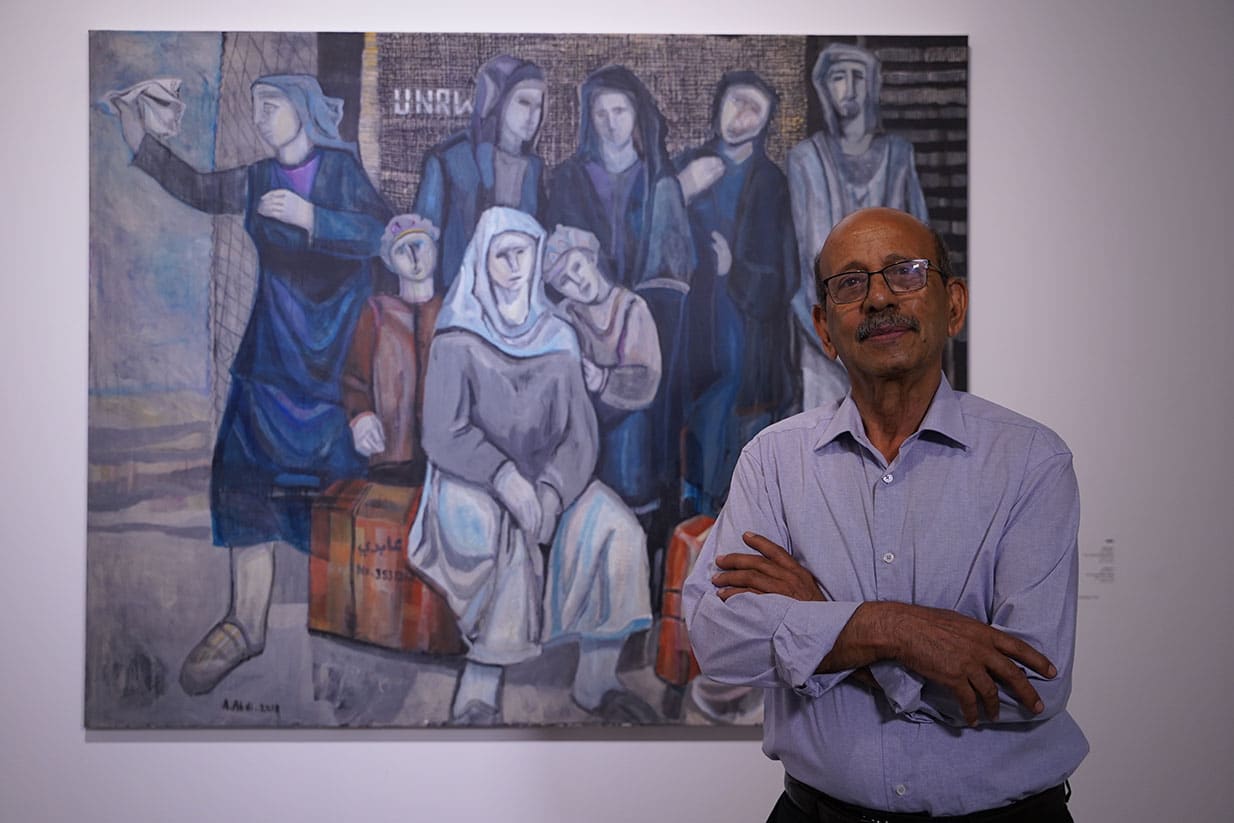 Palestinian artist Abed Abdi stands in front of his painting “Refugees Waiting for Their Return” (2018) at the Haifa Museum of Art. (Gil Mezuman)
Palestinian artist Abed Abdi stands in front of his painting “Refugees Waiting for Their Return” (2018) at the Haifa Museum of Art. (Gil Mezuman) (The Media Line) When he first set out to organize a large-scale exhibition of Israeli and Palestinian art at the Haifa Museum of Art, chief curator Dr. Kobi Ben-Meir had no idea that it would be so timely.
Titled “The Haifa Way,” the exhibition set to open on Friday celebrates the 70th anniversary of the museum. It features the works of a whopping 128 Israeli and Palestinian artists, including masterpieces from the museum’s rich permanent collection and temporary loans.
Thanks to its laid-back atmosphere and multicultural population, the northern Israeli port city of Haifa is typically touted as a beacon of coexistence. The peace, however, was shattered during last month’s flare-up of violence between Arabs and Jews that took place in Israel’s mixed cities, including Haifa.
In light of the recent civil unrest, the exhibition at the Haifa Museum of Art has taken on an urgent new meaning. Ben-Meir hopes it will be part of a wider healing process of Israel’s social wounds.
“It was very depressing what happened here in May, when neighbors turned against one another,” the chief curator told The Media Line following a tour of the exhibit. “For me, the inclusiveness of this exhibition became even more crucial: To show that we have a shared space and a shared purpose.”

One of the many exhibition spaces at the Haifa Museum of Art. (Maya Margit/The Media Line)
For Ben-Meir, it was also important to right what he viewed as a historic wrong; namely, the lack of nearly any Palestinian or Arab Israeli art in the museum’s vast collection.
“It could have collected more Palestinian art,” he said. “Most public institutions in Israel started collecting it only beginning in the late 1980s and early 1990s.
“When you go out to the street from the museum, you hear a mixture of Hebrew and Arabic spoken in tandem,” Ben-Meir continued. “So, I think this museum should embrace this coexistence and reflect it in its own collection.”
Palestinian painter and sculptor Abed Abdi is one of the many noteworthy artists whose works are on display.
The 78-year-old Haifa native was one of the first Palestinian visual artists to formally study art in Germany.
“We should note that local Palestinian art only developed in the 1960s and 1970s,” Abdi told The Media Line. “Before this there weren’t any artists who had studied [visual art] at an academy. I’m one of the first.”
Abdi’s paintings highlight key memories from his childhood.
For instance, the acrylic painting, “Refugees Waiting for Their Return” (2018), depicts the artist as a child standing alongside his family in 1948, the year the state of Israel was founded. Many Arabs living in the newly formed country were displaced from their towns and villages, an event Palestinians refer to as the Nakba, or catastrophe.
“In 1948, we fled for our lives via the port and became refugees,” Abdi recounted. “For nearly three years, my family and I lived in refugee camps – first in Lebanon and then in Damascus, Syria. We then returned via a process of family reunification.”
While he strongly identifies with the story of the Palestinian people, Abdi nevertheless also views himself as being closely tied to the cultural scene in Haifa and Israel more broadly.
The Haifa Museum exhibition places works by Israeli and Palestinian artists on an equal footing and marks an important new chapter for Palestinian art, which Abdi says has long been ignored and excluded by most Israeli cultural institutions.
“I think that this re-examination has the opportunity to influence and to encourage collaboration with Palestinian artists, who are an integral part of the Israeli landscape,” he said.

Detail from Revital Lessick’s “My Four Cubits” (2021) at the Haifa Museum of Art. (Maya Margit/The Media Line)
Israeli artist Revital Lessick also views the large-scale exhibition as an exciting new step forward for culture in the city.
Her incredibly detailed wall drawing “My Four Cubits” (2021) showcases fanciful scenes at various iconic Haifa landmarks. Surrealistic animals, smokestacks and humorous figures dot the large pencil drawing.
Lessick also chose to include one of Haifa’s well-known mosques but, she said, the work is not about coexistence.
“It’s more about personal themes and feelings,” she told The Media Line. “But I do live in Haifa so it’s impossible to ignore that aspect and I’m in touch with people who have different opinions. I think that’s how things should be.”
Other highlights in “The Haifa Way” are Israeli masterpieces by the likes of Yair Garbuz, Batia Grossbard, Hannah Levy and Gershon Knispel. Knispel’s 1956 painting, “The Employment Bureau,” depicts recently arrived Jewish immigrants from North Africa as well as Arab workers standing in line outside the city’s unemployment office. A barefooted Arab girl stands in the foreground dressed in rags while holding a toddler, a stark reminder of the harsh economic reality that many faced in Israel during the 1950s.

Saher Miari stands in front of his installation piece “Strata” at the Haifa Museum of Art. (Maya Margit/The Media Line)
The plight of the Arab worker is also a central theme for self-described Palestinian artist Saher Miari, whose mixed-media installation, “Strata,” greets visitors at the museum’s main entrance. It emphasizes the important role that Arab construction workers played not only in building up the modern city of Haifa, but also in building up many other parts of Israel.
Miari himself worked for several years in construction.
“When I worked in construction, I saw that these people had no rights and also I saw how much they suffered and how hard the work was,” he told The Media Line.
Miari, 46, was born and still lives in a small village named Makr-Jadeidi, located just east of Acre in northern Israel.
“Including Arab and Palestinian artists in this exhibition testifies to their importance in Haifa and also to the uniqueness of this city, which holds a mosaic of cultures,” he said.
“The Haifa Way: 70th Anniversary of Haifa Museum of Art” opens on Friday, June 18 and will remain on display until Jan. 1, 2022.






















 More news and opinions than at a Shabbat dinner, right in your inbox.
More news and opinions than at a Shabbat dinner, right in your inbox.